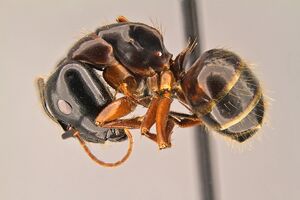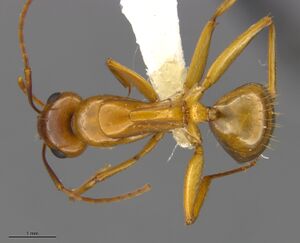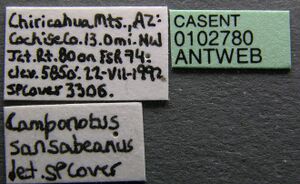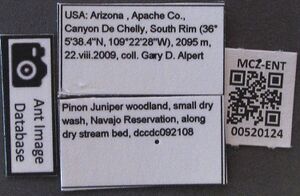Camponotus sansabeanus
| Camponotus sansabeanus | |
|---|---|

| |
| Scientific classification | |
| Kingdom: | Animalia |
| Phylum: | Arthropoda |
| Class: | Insecta |
| Order: | Hymenoptera |
| Family: | Formicidae |
| Subfamily: | Formicinae |
| Tribe: | Camponotini |
| Genus: | Camponotus |
| Species: | C. sansabeanus |
| Binomial name | |
| Camponotus sansabeanus (Buckley, 1866) | |
| Synonyms | |
| |
This species builds nests deep in the ground, often under rocks at the surface. It is polymoprhic with larger darker majors and light-yellow colored minors. Colonies are often found in desert regions and foraging is nocturnal.
Photo Gallery
Identification
Majors have wide heads, and the scape usually just reaches the posterior lateral corner of the head, or passes the posterior lateral corner by less than the first funicular segment. Erect hairs on the head are mostly restricted to the clypeus, but can be found on other parts of the head, and even the sides of the head and ventral surface of the head. The base of the scape is flattened and may even be lobe-like. The color ranges from pale yellow to black, most specimens are bicolored with the head darker than the remainder of the ant. Females are similar, except the scapes are relatively longer and the head is usually noticeably widened near the level of the eye. The petiole of the female is slender in profile, with a sharp apex, the anterior face near the apex is slightly concave. The scape of the male is not flattened at the base. Specimens from southeastern Arizona (Cochise Co.) and western New Mexico (Grant Co.) often have erect hairs along the sides of the head. (Mackay and Mackay 2002)
Distribution
Arkansas and Louisiana westward to, and throughout, the southwestern United States; northern Mexico.
Latitudinal Distribution Pattern
Latitudinal Range: 45.686973° to 19.134994°.
| North Temperate |
North Subtropical |
Tropical | South Subtropical |
South Temperate |
- Source: AntMaps
Distribution based on Regional Taxon Lists
Nearctic Region: United States (type locality).
Neotropical Region: Mexico.
Distribution based on AntMaps
Distribution based on AntWeb specimens
Check data from AntWeb
Countries Occupied
| Number of countries occupied by this species based on AntWiki Regional Taxon Lists. In general, fewer countries occupied indicates a narrower range, while more countries indicates a more widespread species. |

|
Habitat
In New Mexico, where this ant is common (Mackay and Mackay 2002): Sagebrush, pinyon-juniper (most common in this habitat), oaks, ponderosa pine, Chihuahuan pine, rocky ridges near pines.
Biology
For New Mexico (Mackay and Mackay 2002): The nests are usually found under stones, but may be in (and under) rotten stumps and logs, or even under cow manure (especially founding gynes and young nests), in rocky, gravely or loam soils. Brood and reproductives were found in nests in August and September. Dealate females were found in March, May and June and September. This species forages diurnally. Workers are timid and escape when the nest is disturbed. One colony was nesting together with Forelius.
Nevada, Wheeler and Wheeler (1986) - We have 18 records from 18 localities scattered south of the 40th Parallel; 4,700-7,500 ft. All localities are in the Pinyon-Juniper Biome. Six nests were under stones; 7 were exposed with the entrance surrounded by excavated soil in various shapes.
Chemical Ecology
LeBrun et al. (2015) found a behaviour, first noted and resulting from interactions between Solenopsis invicta and Nylanderia fulva, that detoxifies fire ant venom is expressed widely across ants in the subfamily Formicinae. This behavior was also studied and shown in experiments with C. sansabeanus. See the biology section of the N. fulva page for a description of acidopore grooming and the use of formic acid for detoxification of a specific class of venoms that are produced by ants that may interact with formicines in the context of predation and food competition.
Association with Other Organisms
 Explore: Show all Associate data or Search these data. See also a list of all data tables or learn how data is managed.
Explore: Show all Associate data or Search these data. See also a list of all data tables or learn how data is managed.
- This species is a xenobiont for the ant Monomorium minimum (a xenobiont) in United States (Kanizsai et al., 2013; Wheeler, 1901).
- This species is a xenobiont for the ant Pachycondyla harpax (a xenobiont) in United States (Kanizsai et al., 2013; Wheeler, 1901).
- This species is a mutualist for the aphid Thecabius populimonilis (a trophobiont) (Jones, 1927; Saddiqui et al., 2019).
- This species is a host for the phorid fly Apocephalus coquilletti (a parasite) (phorid.net) (attacked).
- This species is a host for the phorid fly Apocephalus similis (a parasite) (phorid.net) (attacked).
Flight Period
| X | X | X | |||||||||
| Jan | Feb | Mar | Apr | May | Jun | Jul | Aug | Sep | Oct | Nov | Dec |
Source: antkeeping.info.
- Check details at Worldwide Ant Nuptial Flights Data, AntNupTracker and AntKeeping.
- Explore: Show all Flight Month data or Search these data. See also a list of all data tables or learn how data is managed.
Castes
Worker
   
| |
| . | |
       
| |
| . | Owned by Museum of Comparative Zoology. |
Soldier
     
| |
| . | |
Queen

| |
| . | |
Male
   
| |
| . | |
Nomenclature
The following information is derived from Barry Bolton's Online Catalogue of the Ants of the World.
- sansabeanus. Formica sansabeana Buckley, 1866: 167 (s.w.q.m.) U.S.A. (Texas).
- Wheeler, G.C. & Wheeler, J. 1953e: 196 (l.).
- Combination in Camponotus: Mayr, 1886c: 365;
- combination in C. (Myrmoturba): Forel, 1914a: 267;
- combination in C. (Camponotus): Emery, 1920b: 255;
- combination in C. (Tanaemyrmex): Creighton, 1950a: 378.
- As unavailable (infrasubspecific) name: Emery, 1893i: 672; Wheeler, W.M. 1902f: 23.
- Junior synonym of marginatus: Mayr, 1886d: 423; Pergande, 1893: 28.
- Subspecies of marginatus: Mayr, 1886c: 365; Cresson, 1887: 257; Dalla Torre, 1893: 242.
- Subspecies of maccooki: Wheeler, W.M. 1910g: 571.
- Subspecies of maculatus: Emery, 1896d: 371 (in list); Wheeler, W.M. 1910d: 307 (redescription); Santschi, 1911d: 7; Wheeler, W.M. 1917a: 560; Cole, 1937b: 139.
- Status as species: Emery, 1920b: 232 (footnote); Emery, 1925b: 75; Cole, 1942: 387; Creighton, 1950a: 378; Smith, M.R. 1951a: 841; Smith, M.R. 1958c: 144; Smith, M.R. 1967: 366; Hunt & Snelling, 1975: 22; Smith, D.R. 1979: 1429; Snelling, R.R. & George, 1979: 188; Allred, 1982: 457; Wheeler, G.C. & Wheeler, J. 1986g: 62; Mackay, Lowrie, et al. 1988: 106; Bolton, 1995b: 122; Mackay & Mackay, 2002: 303; Ward, 2005: 63.
- Senior synonym of bulimosus: Snelling, R.R. & George, 1979: 188; Wheeler, G.C. & Wheeler, J. 1986g: 14; Bolton, 1995b: 122.
- Senior synonym of torrefactus: Snelling, R.R. & George, 1979: 188; Wheeler, G.C. & Wheeler, J. 1986g: 14; Bolton, 1995b: 122.
- bulimosus. Camponotus maculatus subsp. bulimosus Wheeler, W.M. 1910d: 308 (s.w.q.m.) U.S.A. (Arizona).
- Combination in C. (Myrmoturba): Forel, 1914a: 267;
- combination in C. (Camponotus): Emery, 1925b: 75;
- combination in C. (Tanaemyrmex): Creighton, 1950a: 379.
- Subspecies of maculatus: Wheeler, W.M. 1917a: 560; Cole, 1937b: 139.
- Subspecies of sansabeanus: Emery, 1920b: 232 (footnote); Emery, 1925b: 75; Creighton, 1950a: 379; Smith, M.R. 1951a: 841; Cole, 1954f: 272; Smith, M.R. 1958c: 144; Hunt & Snelling, 1975: 22; Smith, D.R. 1979: 1429.
- Junior synonym of sansabeanus: Snelling, R.R. & George, 1979: 188; Wheeler, G.C. & Wheeler, J. 1986g: 14; Bolton, 1995b: 90.
- torrefactus. Camponotus (Camponotus) sansabeanus var. torrefactus Emery, 1925b: 75.
- [First available use of Camponotus maculatus subsp. sansabeanus var. torrefactus Wheeler, W.M. 1910d: 308 (s.w.m.) U.S.A. (Arizona, Utah); unavailable (infrasubspecific) name.]
- Combination in C. (Tanaemyrmex): Creighton, 1950a: 379.
- As unavailable (infrasubspecific) name: Wheeler, W.M. 1917a: 560; Cole, 1937b: 139; Smith, M.R. 1951a: 841.
- Subspecies of sansabeanus: Cole, 1942: 388; Creighton, 1950a: 379; Smith, M.R. 1958c: 144; Beck, et al. 1967: 68; Smith, M.R. 1967: 366; Hunt & Snelling, 1975: 22; Smith, D.R. 1979: 1429.
- Junior synonym of sansabeanus: Snelling, R.R. & George, 1979: 188; Wheeler, G.C. & Wheeler, J. 1986g: 14; Bolton, 1995b: 127.
Unless otherwise noted the text for the remainder of this section is reported from the publication that includes the original description.
Description
Worker
Wheeler (1910) – Major Length, 9-11 mm.; head, 2.8 x 2.7 mm.; scape, 2.5 mm.; hind tibia, 2.5 mm.
Resembling Camponotus maccooki but stouter, more thick-set, with proportionally larger head and shorter legs. The flattened dilatation at the base of the antennal scape is broader than in vicinu8, but slightly narrower and less lobulate than in maccooki. Clypeal carina blunter, lobe of the anterior border shorter.
Sculpture and pilosity as in maccooki, but lower surface of head with more numerous erect hairs. Cheeks with a very few erect hairs arising from some what elongated foveolae. Pubescence very short and sparse.
Color much like that of maccooki, but thorax more brownish, basal half of gaster yellow or yellowish brown, apical half and sometimes the whole gaster more infuscated.
Minor Length, 5-7 mm.
Antennal scapes less dilated at the base than in the worker minor of maccooki. Cheeks without erect hairs. Color much like that of the worker major.
Queen
Wheeler (1910) - Length, 12-14 mm.
Head broader than in maccooki, especially behind. Surface, especially of the thorax and gaster, very smooth and shining. Pubescence more dilute and inconspicuous than in the worker major. Wings long (12-13 mm.), suffused with yellow; veins and stigma brownish yellow.
Male
Wheeler (1910) - Length, 8-9 mm.
Head proportionally shorter than in the male maccooki. Cheeks hairy. Antennal funiculi, tarsi and tibire yellowish brown; wings less suffused with yellow and paler than in the female; veins and stigma pale yellow.
Type Material
Wheeler (1910) - The types of this form were, in all probability, collected by Buckley in central Texas, where it is rather common, nesting under stones in dry woods.
References
- Alatorre-Bracamontes, C.E., Vásquez-Bolaños, M. 2010. Lista comentada de las hormigas (Hymenoptera: Formicidae) del norte de México. Dugesiana 17(1): 9-36.
- Booher, D.B. 2021. The ant genus Strumigenys Smith, 1860 (Hymenoptera: Formicidae) in western North America north of Mexico. Zootaxa 5061, 201–248 (doi:10.11646/zootaxa.5061.2.1).
- Buckley, S. B. 1866. Descriptions of new species of North American Formicidae. Proc. Entomol. Soc. Phila. 6: 152-172.
- Kanizsai, O., Lőrinczi, G., Gallé, L. 2013. Nesting associations without interdependence: A preliminary review on plesiobiosis in ants. Psyche 2013, 238602 (doi:10.1155/2013/238602).
- LeBrun, E. G., P. J. Diebold, M. R. Orr, and L. E. Gilbert. 2015. Widespread Chemical Detoxification of Alkaloid Venom by Formicine Ants. Journal of Chemical Ecology. 41:884-895. doi:10.1007/s10886-015-0625-3
- Mackay, W.P. & Mackay, E.E. 2002. The Ants of New Mexico: 400 pp. Edwin Mellen Press, Lewiston, N.Y.
- Rafiqi, A.M., Rajakumar, A., Abouheif, E. 2020. Origin and elaboration of a major evolutionary transition in individuality. Nature 585, 239–244. (doi:10.1038/s41586-020-2653-6).
- Siddiqui, J. A., Li, J., Zou, X., Bodlah, I., Huang, X. 2019. Meta-analysis of the global diversity and spatial patterns of aphid-ant mutualistic relationships. Applied Ecology and Environmental Research 17: 5471-5524 (doi:10.15666/aeer/1703_54715524).
- Wheeler, G. C. and J. Wheeler. 1986. The ants of Nevada. Natural History Museum of Los Angeles County, Los Angeles.
- Wheeler, W.M. 1901. The compound and mixed nests of American ants. The American Naturalist 35(2-3), 513–539, 791–818.
References based on Global Ant Biodiversity Informatics
- Allred D. M. 1982. Ants of Utah. The Great Basin Naturalist 42: 415-511.
- Allred, D.M. 1982. The ants of Utah. Great Basin Naturalist 42:415-511.
- Andersen A. N. 1997. Functional Groups and Patterns of Organization in North American Ant Communities: A Comparison with Australia. Journal of Biogeography. 24: 433-460
- Beck D. E., D. M. Allred, W. J. Despain. 1967. Predaceous-scavenger ants in Utah. Great Basin Naturalist 27: 67-78
- Cokendolpher J. C., and O. F. Francke. 1990. The ants (Hymenoptera, Formicidae) of western Texas. Part II. Subfamilies Ecitoninae, Ponerinae, Pseudomyrmecinae, Dolichoderinae, and Formicinae. Special Publications, the Museum. Texas Tech University 30:1-76.
- Cokendolpher J.C., Reddell J.R., Taylor S.J, Krejca J.K., Suarez A.V. and Pekins C.E. 2009. Further ants (Hymenoptera: Formicidae) from caves of Texas [Hormigas (Hymenoptera: Formicdae) adicionales de cuevas de Texas]. Texas Memorial Museum Speleological Monographs, 7. Studies on the cave and endogean fauna of North America, V. Pp. 151-168
- Cole A. C., Jr. 1937. An annotated list of the ants of Arizona (Hym.: Formicidae). [concl.]. Entomological News 48: 134-140.
- Cole A. C., Jr. 1942. The ants of Utah. American Midland Naturalist 28: 358-388.
- Cover S. P., and R. A. Johnson. 20011. Checklist of Arizona Ants. Downloaded on January 7th at http://www.asu.edu/clas/sirgtools/AZants-2011%20updatev2.pdf
- Dattilo W. et al. 2019. MEXICO ANTS: incidence and abundance along the Nearctic-Neotropical interface. Ecology https://doi.org/10.1002/ecy.2944
- Degnan, P.H., A.B. Lazarus, C.D. Brock and J.J. Wernegreen. 2004. Host-Symbiont Stability and Fast Evolutionary Rates in an Ant-Bacterium Association:Cospeciation of Camponotus Species and Their Endosymbionts, Candidatus Blochmannia. Systematic Biology 53(1):95-110
- Des Lauriers J., and D. Ikeda. 2017. The ants (Hymenoptera: Formicidae) of the San Gabriel Mountains of Southern California, USA with an annotated list. In: Reynolds R. E. (Ed.) Desert Studies Symposium. California State University Desert Studies Consortium, 342 pp. Pages 264-277.
- Eastlake Chew A. and Chew R. M. 1980. Body size as a determinant of small-scale distributions of ants in evergreen woodland southeastern Arizona. Insectes Sociaux 27: 189-202
- Gregg, R.T. 1963. The Ants of Colorado.
- Hess C. G. 1958. The ants of Dallas County, Texas, and their nesting sites; with particular reference to soil texture as an ecological factor. Field and Laboratory 26: 3-72.
- Hunt J. H. and Snelling R. R. 1975. A checklist of the ants of Arizona. Journal of the Arizona Academy of Science 10: 20-23
- Johnson R. Personnal Database. Accessed on February 5th 2014 at http://www.asu.edu/clas/sirgtools/resources.htm
- Johnson, R.A. and P.S. Ward. 2002. Biogeography and endemism of ants (Hymenoptera: Formicidae) in Baja California, Mexico: a first overview. Journal of Biogeography 29:10091026/
- La Rivers I. 1968. A first listing of the ants of Nevada. Biological Society of Nevada, Occasional Papers 17: 1-12.
- LaBrun, E.G. and D.H. Feener Jr. 2007. When trade-offs interact: balance of terror enforces dominance discovery trade-off in a local ant assemblage. Journal of Animal Ecology 76:58-64
- LeBrun, E.G. 2005. Who Is the Top Dog in Ant Communities? Resources, Parasitoids, and Multiple Competitive Hierarchies. Oecologia 142(4):643-652
- Longino, J.T. 2010. Personal Communication. Longino Collection Database
- MacKay W. P. 1993. Succession of ant species (Hymenoptera: Formicidae) on low-level nuclear waste sites in northern New Mexico. Sociobiology 23: 1-11.
- Mackay W. P., and E. E. Mackay. 2002. The ants of New Mexico (Hymenoptera: Formicidae). Lewiston, New York: Edwin Mellen Press, 400 pp.
- Mackay, W., D. Lowrie, A. Fisher, E. Mackay, F. Barnes and D. Lowrie. 1988. The ants of Los Alamos County, New Mexico (Hymenoptera: Formicidae). pages 79-131 in J.C. Trager, editor, Advances in Myrmecololgy.
- MontBlanc E. M., J. C. Chambers, and P. F. Brussard. 2007. Variation in ant populations with elevation, tree cover, and fire in a Pinyon-Juniper-dominated watershed. Western North American Naturalist 67(4): 469491.
- O'Keefe S. T., J. L. Cook, T. Dudek, D. F. Wunneburger, M. D. Guzman, R. N. Coulson, and S. B. Vinson. 2000. The Distribution of Texas Ants. The Southwestern Entomologist 22: 1-92.
- O'Neill J.C. and Dowling A.P.G. 2011. A Survey of the Ants (hymenoptera: Formicidae) of Arkansas and the Ozark Mountains. An Undergraduate Honors, University of Arkansas. 18pages.
- Reddell J. R., and J. C. Cokendolpher. 2001. Ants (Hymenoptera: Formicidae) from caves of Belize, Mexico, and California and Texas (U.S.A.) Texas. Texas Memorial Museum Speleological Monographs 5: 129-154.
- Rees D. M., and A. W. Grundmann. 1940. A preliminary list of the ants of Utah. Bulletin of the University of Utah, 31(5): 1-12.
- Smith M. R. 1936. A list of the ants of Texas. Journal of the New York Entomological Society 44: 155-170.
- Vasquez-Bolanos M. 2011. Checklist of the ants (Hymenoptera: Formicidae) from Mexico. Dugesiana 18(1): 95-133.
- Vásquez-Bolaños M. 2011. Lista de especies de hormigas (Hymenoptera: Formicidae) para México. Dugesiana 18: 95-133
- Warren, L.O. and E.P. Rouse. 1969. The Ants of Arkansas. Bulletin of the Agricultural Experiment Station 742:1-67
- Wheeler G. C. and Wheeler J. 1973. Ants of Deep Canyon. Riverside, Calif.: University of California, xiii + 162 pp
- Wheeler G. C., and J. Wheeler J. 1989. A checklist of the ants of Oklahoma. Prairie Naturalist 21: 203-210.
- Wheeler G. C., and J. Wheeler. 1986. The ants of Nevada. Los Angeles: Natural History Museum of Los Angeles County, vii + 138 pp.
- Wheeler W. M. 1901. The compound and mixed nests of American ants. Part II. The known cases of social symbiosis among American ants. American Naturalist. 35: 513-539.
- Wheeler W. M. 1910. The North American ants of the genus Camponotus Mayr. Annals of the New York Academy of Sciences 20: 295-354.
- Wheeler W. M. 1917. The mountain ants of western North America. Proceedings of the American Academy of Arts and Sciences 52: 457-569.
- Wheeler, G.C. and J. Wheeler. 1985. A checklist of Texas ants. Prairie Naturalist 17:49-64.
- Pages using DynamicPageList3 parser function
- Photo Gallery
- Need species key
- North temperate
- North subtropical
- Tropical
- Ant Associate
- Host of Monomorium minimum
- Host of Pachycondyla harpax
- Aphid Associate
- Host of Thecabius populimonilis
- Phorid fly Associate
- Host of Apocephalus coquilletti
- Host of Apocephalus similis
- FlightMonth
- Species
- Extant species
- Formicidae
- Formicinae
- Camponotini
- Camponotus
- Camponotus sansabeanus
- Formicinae species
- Camponotini species
- Camponotus species
- Ssr



